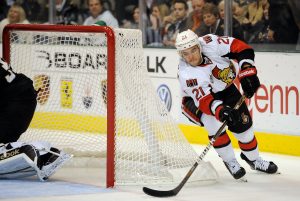
NHL player development seems to always result in more questions than answers. How likely is it for a top pick to pan out? What makes a player a “steal”? Last Word On Hockey will be starting a new series on how to properly develop prospects from all different spots throughout the draft. With forwards drafted out of North American hockey leagues between 2005 and 2015, in the first round, covered, let’s shift to forwards drafted out of Europe.
NHL Player Development Of Top-Ten Picks
In the span of 2005 through 2015, there were 10 players selected within the top-ten out of Europe. Within that grouping, there were three players who made their NHL impacts (15+ games in a single season) in their DY+3 season, or, in other words, after two years of development following their selection in the draft. Those players were Michael Frolik, Mikael Granlund, and Nikita Filatov. In this piece, we will look at Filatov.
In these pieces, Last Word will be using Even-Strength Offence Goals Above Replacement (EVO), Even-Strength Defence Goals Above Replacement (EVD), Wins Above Replacement (WAR) and Goals Above Replacement (GAR). All those analytics come from Evolving-Hockey (paid subscription required).
NHL Player Development Of Nikita Filatov
Nikita Filatov, drafted sixth overall by the Columbus Blue Jackets in the 2008 NHL draft, came out of the MHL’s CSKA Moskva organization in Russia. Playing in the MHL in his DY-1 season, Filatov recorded 13 goals and nine assists for 22 points in 29 games, for 0.759 points per game. That ranked fifth amongst the 10 aforementioned forwards. The following season, he scored 24 goals and 23 assists for 47 points in 23 games, for 2.043 points per game. That ranked first amongst those same 10 forwards in DY production. Filatov would head overseas to the AHL with Columbus’ affiliates at the time, the Syracuse Crunch.
In his first AHL season, he scored 16 goals and assists for 32 points in 39 games, for 0.821 points per game. That ranked sixth amongst the eight forwards still outside the NHL in DY+1 production. The following season, Filatov was loaned back to Russia to play in the KHL with CSKA Moskva. There, he scored nine goals and 13 assists for 22 points in 26 games, for 0.846 points per game. That ranked last amongst the final three forwards still outside the NHL in their DY+2 seasons.
How Filatov Was Used
After the loan out west to the KHL, Nikita Filatov would finally get a role in the NHL. That would not come without a stint in the AHL, however. Playing 36 games in the minors, Filatov scored nine goals and 11 assists for 20 points, a decent statline. Meanwhile, he would see 23 NHL games, where he averaged 12:19 time on ice per game. With the small role in a small sample of games, he scored seven assists. Analytically, he was below replacement-level. His EVO (-2.2) was very poor, with his EVD (1.4) the only stat above replacement-level. However, with his poor offensive impacts, his WAR (-0.3) and GAR (-1.7) were both dragged down.
After a disappointing season, Filatov would follow up with… an even more disappointing season. Getting moved to the Ottawa Senators, it was thought a change of scenery would help. But, he would once again see the AHL, playing 15 games there, scoring seven goals and 12 total points. Getting called up, he would play just nine NHL games, averaging 9:49 per game, with one assist to show for it. The frustrations led to Filatov heading back to Russia that same season. He had 18 KHL games with eight points and one MHL game with three points.
Filatov Leaves For Russia, Never Returns
After fizzling out with two NHL franchises, Nikita Filatov decided he would go back home and play where he knows he can. In his first year back, he played 47 games and scored 21 points (10 goals, 11 assists). He played six more seasons in the KHL before retiring from hockey in 2018-19. In those six seasons, he played 213 KHL games, and scored 101 points. He also saw 25 VHL games (the Russian version of the AHL), scoring 21 points.
Hindsight On The 2008 Draft And The Nikita Filatov Selection
It’s hard to truly judge a player who barely played in the NHL. Maybe Filatov was not totally committed to playing away from home. But if that was the case, that should have been determined before he was drafted at sixth overall in a draft by a team who, at the time, needed NHL talent. It also does not help that the 2008 draft had some good talent as well. Some players taken after Filatov includes Colin Wilson (seventh overall), Mikkel Boedker (eighth), Josh Bailey (ninth), Tyler Myers (12th), Erik Karlsson (15th), Jake Gardiner (17th), Jordan Eberle (22nd), Tyler Ennis (26th), and John Carlson (27th). That does not even include a massive name, like Roman Josi, who was taken in the second round.
Russian hockey players have always been drafted with some form of hesitation. Questions about whether they want to come to North America to play or stay home is a serious question to solve. For example, Andrei Vasilevskiy of the Tampa Bay Lightning. When he was taken 15th overall, there were some questions about if he would be willing to come overseas. But the thing is, when the Lightning had their pre-draft interviews, they uncovered his desire to chase a Cup. Teams can uncover that information. Either Columbus didn’t do their due diligence, or Nikita Filatov was simply impatient and unhappy about how he was being developed. Regardless, Columbus missed out on some big names in 2008.
Raw stats from Elite Prospects and Hockey-Reference
Main Photo: Jerome Miron-USA TODAY Sports
The post Player Development Of Euro Forwards: Nikita Filatov appeared first on Last Word On Hockey.